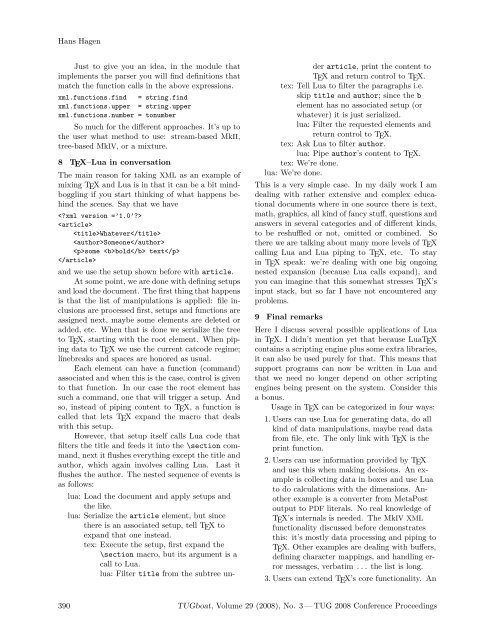The Communications of the TEX Users Group Volume 29 ... - TUG
The Communications of the TEX Users Group Volume 29 ... - TUG
The Communications of the TEX Users Group Volume 29 ... - TUG
Create successful ePaper yourself
Turn your PDF publications into a flip-book with our unique Google optimized e-Paper software.
Hans Hagen<br />
Just to give you an idea, in <strong>the</strong> module that<br />
implements <strong>the</strong> parser you will find definitions that<br />
match <strong>the</strong> function calls in <strong>the</strong> above expressions.<br />
xml.functions.find = string.find<br />
xml.functions.upper = string.upper<br />
xml.functions.number = tonumber<br />
So much for <strong>the</strong> different approaches. It’s up to<br />
<strong>the</strong> user what method to use: stream-based MkII,<br />
tree-based MkIV, or a mixture.<br />
8 <strong>TEX</strong>–Lua in conversation<br />
<strong>The</strong> main reason for taking XML as an example <strong>of</strong><br />
mixing <strong>TEX</strong> and Lua is in that it can be a bit mindboggling<br />
if you start thinking <strong>of</strong> what happens behind<br />
<strong>the</strong> scenes. Say that we have<br />
<br />
<br />
Whatever<br />
Someone<br />
some bold text<br />
<br />
and we use <strong>the</strong> setup shown before with article.<br />
At some point, we are done with defining setups<br />
and load <strong>the</strong> document. <strong>The</strong> first thing that happens<br />
is that <strong>the</strong> list <strong>of</strong> manipulations is applied: file inclusions<br />
are processed first, setups and functions are<br />
assigned next, maybe some elements are deleted or<br />
added, etc. When that is done we serialize <strong>the</strong> tree<br />
to <strong>TEX</strong>, starting with <strong>the</strong> root element. When piping<br />
data to <strong>TEX</strong> we use <strong>the</strong> current catcode regime;<br />
linebreaks and spaces are honored as usual.<br />
Each element can have a function (command)<br />
associated and when this is <strong>the</strong> case, control is given<br />
to that function. In our case <strong>the</strong> root element has<br />
such a command, one that will trigger a setup. And<br />
so, instead <strong>of</strong> piping content to <strong>TEX</strong>, a function is<br />
called that lets <strong>TEX</strong> expand <strong>the</strong> macro that deals<br />
with this setup.<br />
However, that setup itself calls Lua code that<br />
filters <strong>the</strong> title and feeds it into <strong>the</strong> \section command,<br />
next it flushes everything except <strong>the</strong> title and<br />
author, which again involves calling Lua. Last it<br />
flushes <strong>the</strong> author. <strong>The</strong> nested sequence <strong>of</strong> events is<br />
as follows:<br />
lua: Load <strong>the</strong> document and apply setups and<br />
<strong>the</strong> like.<br />
lua: Serialize <strong>the</strong> article element, but since<br />
<strong>the</strong>re is an associated setup, tell <strong>TEX</strong> to<br />
expand that one instead.<br />
tex: Execute <strong>the</strong> setup, first expand <strong>the</strong><br />
\section macro, but its argument is a<br />
call to Lua.<br />
lua: Filter title from <strong>the</strong> subtree un-<br />
der article, print <strong>the</strong> content to<br />
<strong>TEX</strong> and return control to <strong>TEX</strong>.<br />
tex: Tell Lua to filter <strong>the</strong> paragraphs i.e.<br />
skip title and author; since <strong>the</strong> b<br />
element has no associated setup (or<br />
whatever) it is just serialized.<br />
lua: Filter <strong>the</strong> requested elements and<br />
return control to <strong>TEX</strong>.<br />
tex: Ask Lua to filter author.<br />
lua: Pipe author’s content to <strong>TEX</strong>.<br />
tex: We’re done.<br />
lua: We’re done.<br />
This is a very simple case. In my daily work I am<br />
dealing with ra<strong>the</strong>r extensive and complex educational<br />
documents where in one source <strong>the</strong>re is text,<br />
math, graphics, all kind <strong>of</strong> fancy stuff, questions and<br />
answers in several categories and <strong>of</strong> different kinds,<br />
to be reshuffled or not, omitted or combined. So<br />
<strong>the</strong>re we are talking about many more levels <strong>of</strong> <strong>TEX</strong><br />
calling Lua and Lua piping to <strong>TEX</strong>, etc. To stay<br />
in <strong>TEX</strong> speak: we’re dealing with one big ongoing<br />
nested expansion (because Lua calls expand), and<br />
you can imagine that this somewhat stresses <strong>TEX</strong>’s<br />
input stack, but so far I have not encountered any<br />
problems.<br />
9 Final remarks<br />
Here I discuss several possible applications <strong>of</strong> Lua<br />
in <strong>TEX</strong>. I didn’t mention yet that because Lua<strong>TEX</strong><br />
contains a scripting engine plus some extra libraries,<br />
it can also be used purely for that. This means that<br />
support programs can now be written in Lua and<br />
that we need no longer depend on o<strong>the</strong>r scripting<br />
engines being present on <strong>the</strong> system. Consider this<br />
a bonus.<br />
Usage in <strong>TEX</strong> can be categorized in four ways:<br />
1. <strong>Users</strong> can use Lua for generating data, do all<br />
kind <strong>of</strong> data manipulations, maybe read data<br />
from file, etc. <strong>The</strong> only link with <strong>TEX</strong> is <strong>the</strong><br />
print function.<br />
2. <strong>Users</strong> can use information provided by <strong>TEX</strong><br />
and use this when making decisions. An example<br />
is collecting data in boxes and use Lua<br />
to do calculations with <strong>the</strong> dimensions. Ano<strong>the</strong>r<br />
example is a converter from MetaPost<br />
output to PDF literals. No real knowledge <strong>of</strong><br />
<strong>TEX</strong>’s internals is needed. <strong>The</strong> MkIV XML<br />
functionality discussed before demonstrates<br />
this: it’s mostly data processing and piping to<br />
<strong>TEX</strong>. O<strong>the</strong>r examples are dealing with buffers,<br />
defining character mappings, and handling error<br />
messages, verbatim . . . <strong>the</strong> list is long.<br />
3. <strong>Users</strong> can extend <strong>TEX</strong>’s core functionality. An<br />
390 <strong>TUG</strong>boat, <strong>Volume</strong> <strong>29</strong> (2008), No. 3 — <strong>TUG</strong> 2008 Conference Proceedings

















